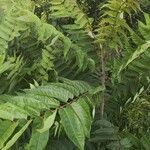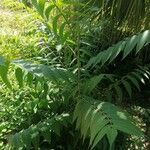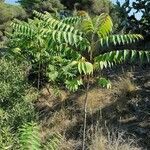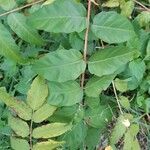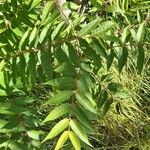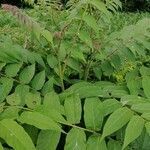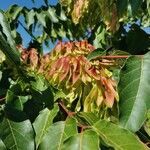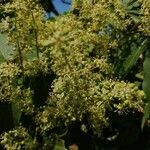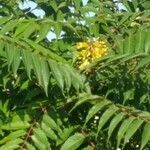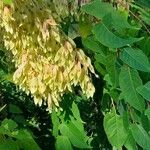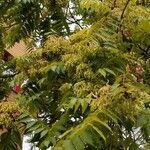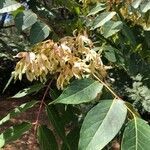A deciduous tree. It grows to 25 m high and spreads 15 m across. The stem is stout and erect. The trunk can be 75 cm across. It forms suckers. The bark is smooth and grey. The leaves are dark green and compound. They are 1 m long. They have unequal leaflets along the stalk. There are 11-41 leaflets. The central stalk is 25-75 cm long. The leaflets are 5-15 cm long. They are widest towards the base and pointed at the tip. They have an unpleasant smell when crushed. There are small basal lobes or teeth near the base. The flowers are yellowish-green. They occur in large erect clusters. They are at the tip of the shoot. The male and female flowers are on separate trees. The male flowers have a bad smell. The fruit are red with wings. There is a seed case with one dry seed and a long twisted wing around it.
Trees, deciduous, up to 20 m tall; bark smooth and straightly grained. Branches with pith, yellow or yellow-brown pubescent when young, then glabrescent. Leaves odd-pinnate, 40-60 cm; petiole 7-13 cm; leaflets 13-27, opposite or nearly so; blades ovate-lanceolate, abaxially dark green, adaxially gray-green, smelly when rubbed. Panicles 10-30 cm. Flowers light green; pedicel 1-2.5 mm. Sepals 5, imbricate, 0.5-1 mm. Petals 5, 2-2.5 mm, base hispid. Stamens 10; filaments densely hispid basally, longer than petals in males, shorter than petals in females; anthers oblong, ca. 1 mm. Carpels 5; styles connate; stigmas 5-lobed. Samarium oblong, 3-4.5 × 1-1.2 cm. Seed in middle of wing, flat-globose. Fl. Apr-May, fr. Aug-Oct.
Deciduous tree to c. 10 m high, suckering from roots to form dense thickets. Leaves mostly with 4 or 5 pairs of leaflets, glabrous or puberulous; leaflets ovate, acute to acuminate, 4–13 cm long, soft, oblique and lobed or dentate near base with abaxial gland near tip of each lobe; stipules caducous, c. 0.5 mm long. Calyx lobes c. 1 mm long. Petals ovate, inrolled, c. 3 mm long, woolly on inner surface and lower margins, white. Stamens in 2 whorls, dimorphic, half to equal petal-length in male flowers, shorter in female. Carpels 5, glabrous; styles connate in lower half; stigmas connate, peltate. Samara c. 4 cm long and 1 cm wide, yellow-red.
Tree or shrub, up to 25 m high; suckers profusely; dioecious. Stems with young branches reddish brown. Leaves imparipinnate; 300-600(-1000) mm long; petiolate; rachis erect, but leaflets tend to droop; leaflets ovate, apices acute to acuminate, margins toothed at base, each tooth with a sessile gland. Flowers: male flowers in axillary cymes on long pedicels, female flowers solitary on long pedicels; calyx 5-parted, sepals 5; petals 5, often very similar to sepals, elliptic, each with a fleshy gland at base, yellowish green; Sep.-Dec., Apr.-Jun. Fruit a samara.
Rapidly growing tree with few branches and coarse twigs; lvs large, to 1 m; lfls 11–41 (the terminal one often imperfectly developed or wanting), narrowly oblong, entire except for one or more coarse teeth near the base, each tooth with a large gland beneath; infl pyramidal, 1–3 dm; fls greenish or greenish-yellow, 5 mm wide; frs 3–5 cm × 7–13 mm, twisted; 2n=80. Native of e. Asia, often escaped from cult. in our range, especially in cities. (A. glandulosa)
